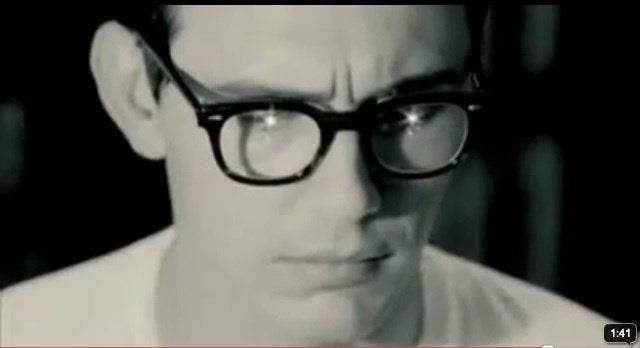
Howl starring James Franco. It sounds like it's going to be another biopic or period drama like most -- all? -- movies about poets, like Sylvia, Bright Star, Il Postino, Barfly. Movies where the idea of poetry trumps the thing itself. You might hear a clip of a poet reading part of a famous poem, or see some scenes in which open books lay scattered about, but mostly those movies could be about physicists, boxers, fighter pilots, or wookies. Poetry doesn't enter the picture, because, let's face it, poetry is scary and Hollywood is, well, not brave. But Howl is different. It isn't about the life of the poet, the times of the poet, the friends of the poet, or even the inappropriate drunken benders of the poet. It's about the poem. It's about Allen Ginsberg's "Howl" -- the words, the style, the literary tradition, and the form. The poem is the focus, the feature, and the star, which is crazy. Is there another movie in the history of American cinema like it? I can't think of one. For the sake of argument, let's say there isn't.
But, I'll admit, before I saw the film, all I knew about it was James Franco. So when I settled into the Lake Street screening room near the carbide and carbon building in Chicago, I thought it would be like any other press screening, except with a little more of America's finest actor / soap-star / grad-student / performance-art provocateur.
The room smelled of sweat and cheese steak; a woman in stretch pants talked to a man in a beret about her Hebrew name; the projectionists argued about Pixar stock; Roger Ebert arrived -- notebook, pen and black turtleneck in view. It could have been Beverly Hills Chihuahua. But then the room went dark, and for the next ninety minutes, we didn't just watch the formula stream across the screen. We watched a star-filled Hollywood cast engage in a close reading of a 53 year old poem. Holy! Whatever you think of the film -- and, of course, even before it opens next Friday it's already accrued its defenders and detractors -- you have to admit this is an extraordinary thing.
Shot in cool black-and-white with a lot of smoke and leather, the first thing we see is Franco-as-Ginsberg shyly beginning his reading at the Six Gallery in San Francisco. It's what we might expect for the rest of the film from the publicity shots, but as soon as Franco inhales and spouts the line "who poverty and tatters and hollow-eyed and high sat up smoking in the supernatural darkness of cold-water flats floating across the tops of cities contemplating jazz" the screen explodes into a Mad Men-esque montage of Erik Drooker's animation, and all those biopic expectations go out the window.
No doubt, the animation is and will be the most contentious part of the film. And at first, it is jarring -- as only animated penises shooting stars from their tips into the galaxy can be. After a while, though, the animated interludes feel more integrated and strangely in the spirit of Ginsberg's 1950s, but there's always the question of whether or not they're necessary at all. Of course, I'm a poetry junkie, so I could just listen to Ginsberg read for ninety minutes while staring at a blank screen. In fact, I have. Pretty often. I used to drive from Georgia to Iowa a few times a year listening to a tape of Ginsberg reading "Howl" and "America" for inspiration to power me through blizzards. But for non-freaks, perhaps the visuals will add a layer to what otherwise might seem like an impenetrable wall of language -- though what beautiful language!
Then, we also have the courtroom drama, in which Jon Hamm and David Strathairn go back and forth, line-by-line and sometimes word-by-word, over the meaning and merits of the poem in a re-creation of the 1957 obscenity trial of Ginsberg's publisher, City Lights. Here's where we get the wonderful cameos by Mary Louise Parker and Jeff Daniels as literary establishment fuddy-duddies, and David Strathairn playing devil's advocate for the prim philistines who would just rather not hear about who's blowing and who's getting blown.
Interspersed between these two settings, there's also a dramatization of Ginsberg at home in his New York City apartment, interviewed about "Howl," the trial, and his writing process. The interview calls up flashbacks to Ginsberg's life -- his pre-"Howl" jobs, his love affairs with Neil Cassady and Jack Kerouac, and his moody walks around various cities. This is where Franco shines. His embodiment of Ginsberg contains just the right mix of sentimentality, ego, and humor to help us remember that Ginsberg was incredibly funny, and much more self-aware than it might have appeared when he was stuffing flowers into rifles. Franco captures that humor without losing the humanity.
While he'll most likely continue to capture most of the attention for Howl, don't be fooled. Filmmakers Rob Epstein and Jeffrey Friedman have made the poem the film's thing for what may be the first time in American movies. Anyone interested in poetry and its more popular manifestations should try to remember the extra brilliant and intelligent kindness of the soul and see how they did it.